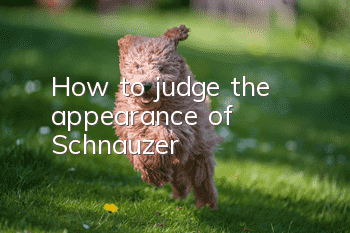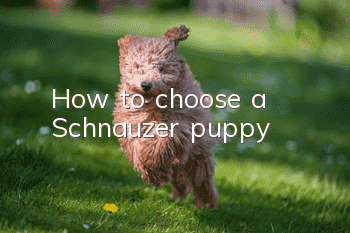How to distinguish between good and bad Schnauzers

[Body shape]
The shoulder height range is 12 inches to 14 inches. The body structure is solid, the body is nearly square, the height and body length are roughly equal, the bone mass is sufficient, and no part looks like a toy.
[Head]
The eyes are small, dark brown, and set deeply. The eyes are oval and sharp. Ears, if trimmed, are of uniform shape and length, with pointed upwards. Their length should be proportionate to the size of the head and no exaggerated length is allowed.
The ears are set high on the top of the head, with the inner edges pointing straight up and the outer edges possibly being slightly bell-shaped. If the ears are not cropped, they will be small, V-shaped, and folded over the top of the head (button ears).
The head is strong and rectangular in shape, the width of which gradually decreases from the ears to the eyes and then to the nose. Forehead has no wrinkles. The forehead is flat and fairly long.
The muzzle is parallel to the forehead, has a stop, and is the same length as the forehead.
The muzzle is strong and in proportion to the entire head; the end of the muzzle is moderately obtuse and has a thick beard to form a rectangular head profile.
The bite is a scissors bite.
[Neck, topline and body]
The neck is strong and slightly arched, perfectly integrated with the shoulders. The skin of the throat is compact and wraps the neck just right.
Body short and deep, with chest reaching at least to the elbows. The ribs are well sprung and of good depth, integrating well back into the short loin.
Topline straight; sloping slightly downward from withers to root of tail.
The withers is the highest point of the body. The length from breast to rump is equal to the height of the withers.
The tail is set high at the base and carried upward. The tail needs to be docked, and the remaining length is: when the dog's coat is of appropriate length, the length just exceeds the topline.
[Forequarters]
Viewed from all angles, the forelimbs are straight and parallel to each other.
They have strong wrists and plenty of bone. Chest of moderate depth located midway between the forelegs. Keep your elbows close to your body.
Shoulders are sloping, muscular, flat, and clean. They blend well into the back so that the sides of the shoulder blades are directly above the elbows.
The shoulder blades are tilted forward and downward, and at an appropriate angle, so that the forelimbs can extend forward to the maximum extent without being restricted. The shoulder blades and forearms are both long, allowing sufficient depth to the chest. The feet are short and round (cat feet), and the pads are thick and black. Toes are arched,compact.
[Hindquarters]
The hindquarters have muscular, sloping thighs. Proper angle at the stifle joint. There is sufficient angle so that the hock ends extend beyond the tail in the standard stance.
The hindquarters appear not to be larger or higher than the shoulders. The hind ankles are short, perpendicular to the ground in the standard stance, and parallel to each other when viewed from behind. Faults: sickle legs, bull legs, o-legs or crooked hind legs.
[Coat]
Double coat, with a hard outer layer of bristles and a dense undercoat. The head, neck, ears, chest, tail and body need to be stripped.
[Color]
Recognized colors are salt and pepper, black silver and solid black. Regardless of the color, the pigmentation of the skin must be very even, that is, white or pink patches anywhere on the skin are not allowed.
1. Salt and pepper color: The typical salt and pepper color is formed by black and white hair, pure black, and pure white hair. Black and white hair is the mainstream. A variety of salt and pepper colors are acceptable, from lighter salt and pepper colors to darker, salt and pepper colors with shades of brown. The salt and pepper dog's coat color will gradually transition to light gray or silvery white in the following areas: eyebrows, beard, cheeks, under the throat, inside the ears, chest, under the tail, lower half of the legs and inside of the hind legs. Additionally, the underside of his belly may also become lighter in color. However, the lighter portion should not extend to the sides of the body, above the elbows.
2. Black and silver: The style of black and silver is the same as that of salt and pepper. Must be solid black where salt and pepper is. The black and silver coat should have a black undercoat. Any hair that has faded to brown needs to be removed, and the hair under the belly should also be dark.
3. Pure black: Pure black is the only recognized single color. The ideal color is a very dark coat with a lighter, soft undercoat, which is ideal everywhere. Brown or faded hair should be removed. The hair color will become lighter if you shave it with scissors or electric clippers. Small white spots on the chest or occasional white hair elsewhere on the body are permitted.
[Gait]
Looking at the forelegs from the front, the elbows are close to the body and pointing straight forward, neither outward nor inward. When viewed from behind, the hind limbs are straight and move in the same plane as the corresponding forelimbs. Note that generally after completing a brisk walk, the hind legs will continue to move in the same plane as the front legs, but a slight inward tilt is allowed. Viewing from the front should be based on the shoulder point, and viewing from the back should be based on the hip joint point. Whether viewed from the front or rear, the forelimbs or hindlimbs are vertical from the reference point to the ground. When a Miniature Schnauzer walks, the angle of its legs tilted inward is so small that it is almost invisible to the naked eye. The toes cannot be crossed and the elbows cannot be turned out. Viewed from the side, the forelegs can be fully extended and the hindquarters have strong driving force. Feet do not turn in or out.
[Temperament]
The typical Miniature Schnauzer is brave, alert, and docile. He is very friendly, intelligent and loves to please his owners. Never be aggressive or overly timid.
- What is the use of probiotics for puppies?
- How to take probiotics for puppies
- How to raise a two-month-old Schnauzer
- How to feed Schnauzer puppies
- How to feed pug dogs
- How to take a bath for a little Pomeranian
- What is Basset's personality like?
- What is the temperament of a Yorkshire Terrier?
- How do you tell the age of Papillon dogs?
- How do you tell whether a pug is pure or not?



